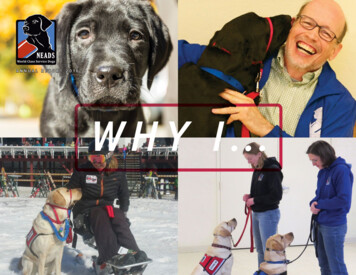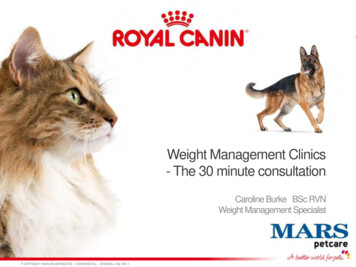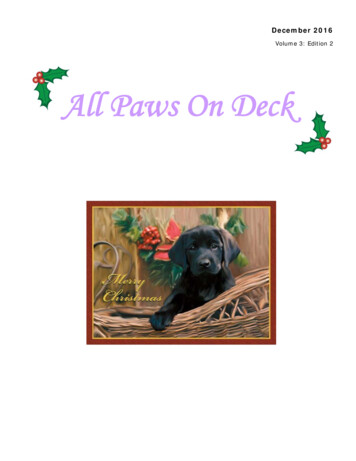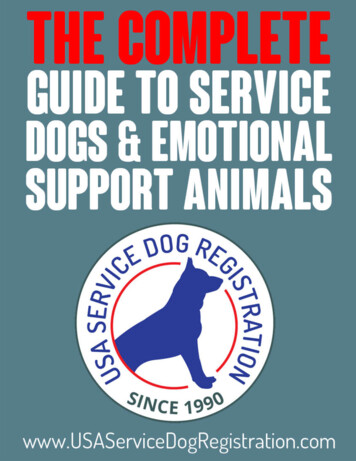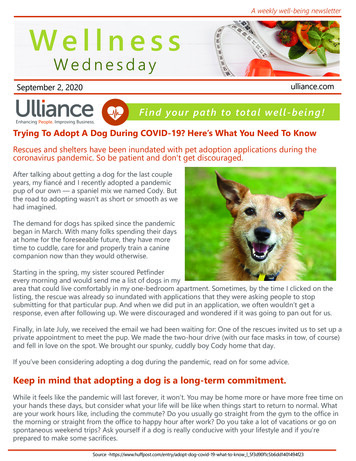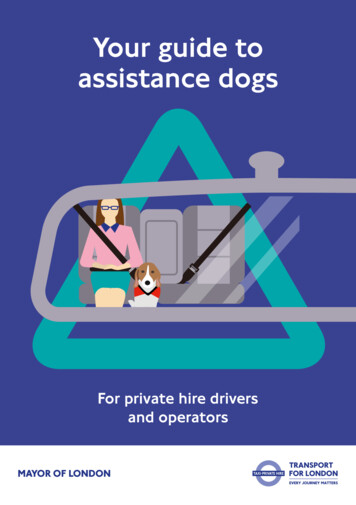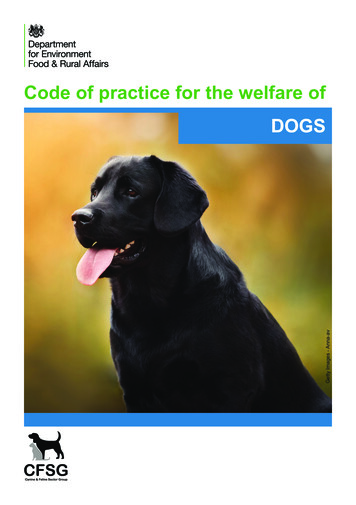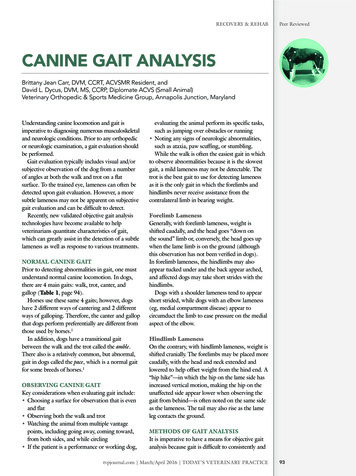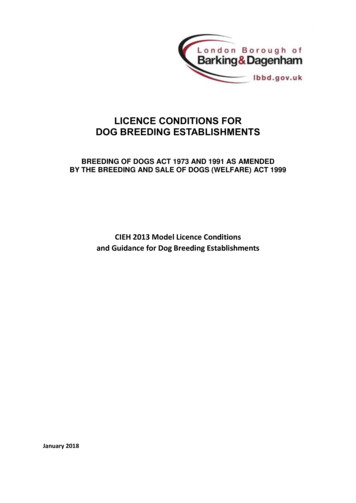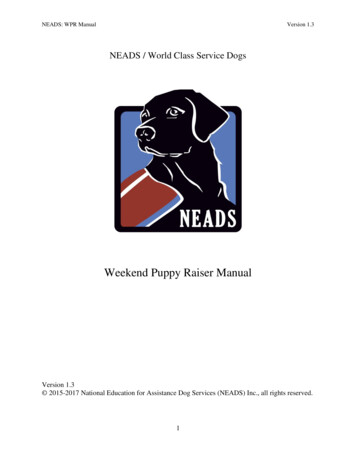
Transcription
NEADS: WPR ManualVersion 1.3NEADS / World Class Service DogsWeekend Puppy Raiser ManualVersion 1.3 2015-2017 National Education for Assistance Dog Services (NEADS) Inc., all rights reserved.1
Version 1.3NEADS: WPR ManualWeekend Puppy Raiser ManualVersion 1.3Updated December 2017The Addenda section contains information that will be integrated into the manual during thenext update cycle, but that Puppy Raisers should begin implementing immediately. Contact theDirector of Canine Operations or the Puppy Program Assistants for more information.This manual has supplementary packets: NEADS Field Trips Packet NEADS Full Time Raiser Packet NEADS Waivers and Forms for WPR MBTA Application for Fixed-Route Training PassCopyright 2015-2017 National Education for Assistance Dog Services (NEADS), Inc.All rights reserved. This manual, or any portion thereof, may not be reproduced or used in anymanner whatsoever without the express written permission of the Director of CanineOperations or Chief Operating Officer of NEADS.Main phone number: 978.422.9064Campus:305 Redemption Rock TrailPrinceton, MassachusettsFax: 978.422.3255Mailing address:PO Box 1100Princeton, MA 015412
NEADS: WPR ManualVersion 1.3Table of ContentsLetter from Gerry . 5Letter from Lacy . 6Commitment . 7Before Bringing Your Pup Home . 8Equipment List . 9Key Concepts to Understand . 11First Weekend Discussion. 15Rules for Riding in the Car . 18Introducing Dogs and Cats. 21Dog Body Language Visual Glossary. 25Great Management . 28House Training. 32Feeding . 35Real Life Rewards. 38Different Types of Barking . 40Drag Line . 41Training Terms. 43Daily Exercises List . 48Crate Practice . 49Alone Training . 51Food Bowl Exercises . 52Object Exchange . 53Handling and Grooming . 55Socialization at Home . 57Socialization: Town Trips . 60Relaxed Down . 61Meeting People and Dogs . 62Play Retrieve / 1 Mile Walk. 64PUP'S NAME, COOKIE . 66Loose Leash Walking . 67The Leash Wrap . 68Get Dressed . 693
Version 1.3NEADS: WPR ManualVisual Guide to Getting Dressed . 71Stress Indicators . 73C-BARQ Instructions. 77MBTA Volunteer Pass . 77Turning the Pup in to the Kennel . 78Wheelchair Etiquette . 80Puppy Program Exit Questionnaire . 81Meet and Greet Etiquette . 85Suggested Reading . 87Copies of Waivers and Forms . 89NEADS Staff . 96NEADS Puppy Raiser Council . 97Prison Contact Information . 98Stool Classification . 100Addenda . 1014
NEADS: WPR ManualVersion 1.3Letter from GerryDear Puppy Raiser,The team at NEADS thanks you for opening up your heart as well as your home. By caring forthis puppy you will provide the foundations of love upon which all Assistance Dogtraining willbe built.Our commitment to provide the very best trained dogs to function as helpmates for individualswith physical disabilities depends on your skills and willingness to: Love and care for your puppy as you would a member of your own family so that yourpuppy learns to trust and love in return. Expose your puppy as often as possible to all sorts of different situations. Remember toalways ask permission first and Educate, Educate, Educate. Romp and play with your puppy while insuring that the puppy accepts the rules of thegame and knows how to stop when play time is over. Introduce your puppy to your friends and relatives so that the puppy feels confidentaround lots of different people.It is impossible to overstate the critical importance of the puppy raiser's role in helpingindividuals with disabilities achieve a life of independence. Simple state that is our mission.Your puppy will pass your gift of love and caring on to someone in need of it. What greater giftis there? Welcome to the NEADS family. We appreciate all that you do.Sincerely,Gerry DeRocheChief Executive Officer5
Version 1.3NEADS: WPR ManualLetter from LacyWelcome!It is our goal to help make your puppy raising experience a rewarding project. Our puppies aresome of NEADS’ most valuable assets! We are indebted to the many generous volunteers whobelieve in NEADS and who donate countless hours to us. Without you our program would not bepossible.We understand that many of you have dogs of your own and have your own preferred raising andtraining methods and that you may not always agree with ours. This manual and its guidelineshave been developed through our years of experience and with the best interests of our dogs andclients in mind. We trust that as part of your commitment you will follow our guidelines so thatour dogs are prepared for their future work. We are committed to providing you with all theinformation that you will need to raise a well-socialized, confident NEADS AssistanceDogcandidate through written materials, communication with your Puppy Raiser Councilrepresentative, and resources in your community.Thank you for participating in our Puppy Program. Without your dedication and hard work wewould not be able to place as many Assistance Dogs as we do!Lacy GillottiDirector of Canine Operations6
NEADS: WPR ManualVersion 1.3CommitmentNEADS asks that you commit to the following for the length of the pup's training: The Puppy Raiser agrees to take the pup out a minimum of 3 weekends a month andattend 1 training class with the Puppy Program Assistants (PPA) each month. For Weekend Puppy Raisers, a Weekend Communication Sheet should be filled out andhanded in with the pup when he is returned to prison each week. All Puppy Raisers must have access to a computer and be prepared to communicate withthe Puppy Program Assistants (PPA) and other NEADS staff primarily through email. Weekend Puppy Raisers should email the Puppy Program Assistants (PPA)and the PrisonLiaison by Wednesday of each week to notify them if the pup is going out for theweekend or not. NEADS pups are only allowed out Friday night to Sunday night, as there is trainingtaking place in prison all week. If a raiser wishes to take the pup out during the week, orkeep the pup for a long weekend, they must ask the Puppy Program Assistants(PPA) forpermission ahead of time. At least once a month, email the Supervisor of Foundation Relations a recent photo of thepup.7
Version 1.3NEADS: WPR ManualBefore Bringing Your Pup HomeMake sure you have everything you need: check the equipment list on page 9.Puppy proof your house, anything lying on the ground is a chewing opportunity for the new pup.Read your manual! Reading other books found on the suggested reading list is highlyrecommended as well.Make sure your family is aware of the Do’s and Don’ts of service dogs in training. See page13for more information.If you are a Weekend Puppy Raiser, make sure your orientation at your Department ofCorrections/Bureau of Prison has been arranged. The Puppy Program Assistants (PPA)willprovide you with your prison liaison’s contact information. Please understand that the prisonliaison is a volunteer, not a NEADS employee.You will be given an emergency veterinarian card along with emergency procedures to follow,keep this handy at all times.Only use the equipment that the pup is wearing when he is given to you. If any equipment needsto be replaced, contact the PPAand make note of it on the Weekend Communication Sheet.NEADS will supply you with food for the pup. If you have not met with the PPA before gettingthe pup, make sure to ask your liaison to send the pup out with food for the weekend. ThePPAwill give you food at your first class if necessary. It is important that the pup stay on thesame food that he is fed in prison.The pup will come to you with a Weekend Communication Sheet; this should be filled out andhanded back in to the inmate handler when the pup is returned to prison.FAQ'sQ:Can I buy a new collar and leash for the NEADS puppy?A:We ask that you use the leash and collar that the pup is wearing when he is given to you.If there is a problem with the equipment and it needs to be replaced, tell the prisonliaison and the PPA. Also, please note it on the Weekend Communication Sheet.Q:Can we tie the dog outside or leave him in the yard alone?A:NEADS puppies should always be supervised. They should never be left outside aloneor with other dogs. If the pup is not with you then he should be in his crate.8
NEADS: WPR ManualVersion 1.3Equipment ListYou will need to provide these items for the NEADS pup. 2 Stainless steel bowls: Plastic bowls are not recommended because they are more likelyto be chewed, scratched, and harbor bacteria. Crate: Either molded plastic or wire is acceptable. While in the crate, the pup shouldhave enough room to stand up and turn around, any extra space will give the pup roomfor accidents (a little pup in a big crate will result in a big mess). Some wire crates comewith a divider so you can make the crate bigger as the pup grows. Crate mat or Bed: Only for older pups that are not soiling in the crate and will not chew. 30’-75’ Drag Line (unless otherwise noted by trainer): NEADS puppies are alwayskept on leash, even in a fenced in yard. The long line should be attached to the pup’s flatcollar during all exercise and play sessions. This is a drag line; you do not hold it or tie itto anything unless otherwise noted. If you prefer, you can buy a clothes line and a leashclip to make your own drag line. Tab Leash: A tab leash is a 12 inch leash that will attach to the pup’s flat collar from 610 months of age while he is in the house. You can make your own by cutting an oldleash or buy one in the pet store. You should never use the tab leash in public. Nature’s Miracle: To neutralize “accidents.” Or you can make your own solution bycombining 50% water with 50% vinegar. Brush/Comb: The pup should be brushed out daily. Crate/Tether for car: Always remove the cape and gentle leader when the pup is ridingin the car. If you have to put the NEADS pup in the far back section of your car wehighly recommend having him ride in a crate since you will not be able to see him or stophim from chewing things or jumping over the seat. If he is riding in the seat behind thedriver and passenger seat you can use a crate or a tether. When tethering the pup (usuallyunder 6 months), he should have enough slack to lie down comfortably but not enough tosit up. Since the pup is not allowed to bark out the window at things, the tether helps keepthe pup’s head below the window. If the pup starts to chew on the leash you can spray theleash with Bitter Apple Spray to deter him. Also keep a Nylabone in the car for the pup(remove the bone if other dogs are riding in the car with the NEADS pup). Pooper Scooper or Plastic Bags: Always pick up after your NEADS puppy. A cape orbackpack will be given to you for the puppy to wear; we highly suggest keeping plasticbags and paper towels in the pockets of this equipment in case of accidents. Baby Gates: These are a management tool. See the section Great Management on page9
Version 1.3NEADS: WPR Manual28 for more information.They can be used to: block a doorway to keep the pup fromgoing in or out, separate the pup from other dogs, cats or people, keep the pup in a“puppy proofed” room (bathroom, kitchen), and used as a surface to have the puppractice walking over. Chew Toys: Kong brand items, puzzle toys to work the pup’s brain, and Nylabones areappropriate chew toys. Squeaky toys, stuffed animals, and tennis balls are not chew toys- these toys are for interacting with the pup and play retrieve only. The use of any deadanimal parts (rawhide, hooves, pig ears, sterilized marrow bones, etc.) is not allowedand is against NEADS policy. Interactive Toys: Tennis balls, plush toys and squeaker toys should only be used whenyou are actively playing with the pup. These are the items to use when practicing playretrieve (see pages 29 and 64 for more information). The NEADS pup should not haveaccess to these toys if you are not playing with him. Treats: Kibble (the pup’s main food) should be your primary treat. The pup is allowed ½cup of NEADS approved treats in addition to the meal ration. There is a hierarchy to theNEADS approved treat list, let’s think of treats in terms of money:o 5 Kibbleo 20 Charlee Bears or Natural Balance food rollo 50 low fat cheese, kosher hot dogs cut up into tiny pieces, freeze dried liverIn general, the special or “high value” treats will be reserved for distractions (doingobedience around dogs) and for recalls (if your trainer has you practicing them). Theymay also be used with a desensitizing program for dogs with certain fears. Please save thehigh value treats for when you need them most, use the kibble for as much as you can.Please only use the NEADS approved treats in this section.Equipment You Will Not Need to Provide Collars and Tags: NEADS will provide the pup with a flat collar and a NEADS tag.This collar should be worn at all times. The collar should be adjusted to fit snuggly sothat you can only fit two fingers under it. While the pup is growing you may have toadjust this daily. We do not allow the use of choke chains or prong collars on puppies intraining. Rabies Certificate: A copy of the pup’s rabies certificate will be given to you. You willnot be given the rabies tag; the tag will be kept in the pup’s medical file. Bandanas/Capes/Backpacks: NEADS puppies in training wear blue capes, backpacksand bandanas that will be given to you when the pup is ready for them. Please read abouthow to get the pup dressed on page 69.10
NEADS: WPR ManualVersion 1.3Key Concepts to Understand You have 2 seconds to correct or praise the pup or the pup will not associate it with whathe did. The rewards in training must actually be rewarding to the pup. Is your verbal/physicalpraise actually reinforcing? Does the pup care about your influence? Here are someexamples of ways you can reward the pup for good behavior:oooooVerbal praisePhysical praiseGames with toysDifferent food treatsFreedom (play time, walks) You are the pup’s model/leader. Use body language, tone of voice, and emotional state togive appropriate feedback/instruction to the pup. (Genuinely happy tone/emotion/bodylanguage should be paired with giving of rewards, as should genuinelydisapproving/disgust tone/emotion/body language be paired with removal or withholdingof rewards, etc.) Give the pup the measured amount of food and no more than ½ cup of NEADS approvedspecial treats a day; for health reasons and so as not to trash the value of these treats.Whenever treats are given, it should be done with forethought.o Special treats should really only be used for distraction work and recalls (if trainerallows) as a general rule.o Always try to use the lowest value reward that the pup will work for. Part ofobedience training is that he has to do things he doesn’t want to some of the time.Raising a service dog is not about food treats and you are not a food dispenser.o Understand that just because the pup is taking treats from you in certain situationsdoesn’t mean the pup is okay. It’s true that some pups don’t eat when they arestressed, but just as many pups do eat when they are stressed (especially labs!). The only way to get the pup more comfortable around his fears is throughconstant repetition and repeated exposure which allow the pup tohabituate, to learn that these places and people are of no consequence tohim. Discover the pup’s favorite games, treats, places to be scratched or activities. You need toknow these in order to use them effectively to train the pup. No tugging games unless you have permission from the NEADS trainer or PPA.11
Version 1.3 NEADS: WPR Manual“What-Where-When” Training:o What: Teach the commands in a non-distracting environment.o Where: Practice the commands (training) in all the environments the pup willneed to perform in.o When: Train in real life as well as “practice” sessions. Ideally we are looking foran hour of special training practice daily, in addition to training in real life.(Example: You don’t just sit your children down and have a meeting on “pleaseand thank you,” you teach them as the moments are happening in real life. Youcoach them until they do it on their own.). Use the umbilical cord method (literally fasten the pup to you, using a leash) for at leastthe first month of in home training. By default, house training, manners and bonding willbe set on the right track. See page 15 for more details on this. If you have other dogs in the house, the NEADS pup should be kept separate from them(use baby gates to block off rooms, dogs should not be able to see or sniff each other) andhave limited interaction.o No more than 20 minutes of play a day, and they can only play if your pet is asuitable playmate; ideally, calmer, older and appropriate with other dogs.o Dogs that play together should use toys to interact with, limit any wrestling. If onedog is being pinned/bullied/barked at/ humped obsessively then end play andcontact the PPA.o Dog-dog playing should come after you have played with the pup (see PlayRetrieve on page 29), playing with other dogs should not be a substitute forplaying with you. If the NEADS pup would rather play with your pet dog thanwith you, that is a problem. You should be the pup’s first bond. There should be one primary handler/trainer for the pup. This person should also be theprimary caregiver; i.e., the one who feeds, walks, plays with, etc. This is necessarybecause it directly affects the amount of influence you have on the pup while training. In general, we are teaching the future service dog to ignore other dogs and people. Under6 months of age, we are a little more lenient in terms of meeting people and dogs (butpractice manners when doing so). Through repetition and advancement the NEADS pupwill learn that other dogs and people (as well as public places etc.) are of no importanceto him. Key learning concepts for you to be aware of:o Trial and Error: Dogs do what works. Example: barking in the crate. If you pay12
NEADS: WPR ManualVersion 1.3attention to the pup or let him out, the pup learns that barking works (seeDisassociating Time below for the key to this).o Observational Learning: You are the pup’s role model and leader. The pup willpick things up from you; confidence, fear, anxiety, excitement, etc. The pup willassociate your emotions with environments and contexts.o Associative Learning: The pup learns that the leash means walks, car keys meanyou are leaving, gentle leader/cape/backpack mean it’s time to work, etc. It’simportant to be aware of the associations the pup is making.o Disassociating Time: In order to be certain that the pup is not associatingsomething with a consequence, you should allow for at least 2-5 minutes to go bybefore you move on. Example: the pup experiences a frightening event on apublic trip. Settle the pup in a sit, and wait until the pup relaxes before leaving thearea. If the pup goes to lie down, that’s okay.o Say it and make it happen: the pup will not reliably associate commands andwords with behaviors you expect if you don’t use consistent commands to beginwith and if you don’t make sure it happens after you say it the first time.Repeating commandsisnot good practice.Service Dog RulesWhat’s different from a pet? Never feed the pup from the table, including dog treats. Only feed treats that are on the NEADS approved treat list on page 10. All four on the floor; don’t let the pup jump up on people. This is easy to do, justanticipate it happening. The pup sleeps in the crate with the door closed; don’t let him in your bed or on yourcouch. The pup is on leash at all times; use the drag line when exercising the pup unlessotherwise noted by the pup’s trainer. Line should not be held/tethered unless otherwisenoted. The pup is always with you or in the crate; don’t leave him outside without adultsupervision. Children under 18 should never be left unsupervised with the pup and should not handlethe pup in public.13
Version 1.3NEADS: WPR Manual Don’t pick up or carry the pup, unless just to put him in the car when appropriate. The pup should never chase anything (cat, small animals, lasers, etc.) other than a toy inplay retrieve sessions. No roughhousing with the pup. Limit interactions with other dogs. No more than twenty minutes a day, three times aweek, unless otherwise noted. Play time should preferably be with calmer, friendly, olderdogs. Measure daily food exactly with measuring cups. Food should be level, not heaping.14
NEADS: WPR ManualVersion 1.3First Weekend DiscussionA guide to your first weekend with the NEADS pup.Umbilical Cord Method For the first month of training, the pup should be attached to you by the leash at all timesin the house and outside the house. After the first month, keep the leash on the pup so he can drag it around while in thehouse (keep hold of it while in public) and use the leash to stop any house training issues(jumping on counters or furniture, stealing food, jumping on people, etc.). Once the pup is 6 months old, you can progress to having him wear a tab leash (page 9).The pup should have the tab leash attached to his flat collar while in the house until he is10 months old. The tab leash can be used to correct the pup for any house trainingincidents or mismanagements. Because the leash is so short he will feel more “free” thanhe did while dragging his regular leash. The pup should never be taken in public whilewearing the tab leash.A Quiet WeekendIf this is your first weekend with a new NEADS pup, whether you are new to the program orhave raised other dogs, please keep things low key. Let the pup spend the weekend getting toknow you, your family, your house and your neighborhood, but do not go out into public.Avoid Taking Any Trips with the PupStay home this weekend. If you do go out, leave the pup at home in a crate with things to do(stuffed Kong, Nylabone).Using the CrateThe pup should sleep in the crate with the door closed in your bedroom at night. The pup shouldalso be crated in a central room periodically throughout the day. The crate will inhibit the pupfrom having accidents or chewing things and as such will aid in house training. Young pups need100% of your attention so if you can’t keep an eye on the pup, put him in the crate withsomething to do. At a minimum, the pup should be in the crate 3 times a day for 20 minutes each(you can feed breakfast, lunch and dinner). Whining in the crate:Do not make eye contact or communicate with the pup when he isin the crate. Also try to avoid responding to any whining. A little whining in thebeginning is normal and should go away if the pup has something to do while he is in thecrate. Make sure to wait 2-5 minutes after the pup has stopped whining before you let15
Version 1.3NEADS: WPR Manualhim out of the crate. If the pup is under 12 weeks old, whining in the crate may mean thepup has to go to the bathroom. Be careful about making a habit out of letting the pup outto bathroom when he whines, he will catch on to this and could develop an annoyinghabit of whining when he wants something, which is not an acceptable trait for servicedogs.Bathroom OpportunitiesFor the first 24 hours that you have the pup, give him a chance to go to the bathroom every hourthat you are awake. Dogs quickly develop patterns of behavior; if possible, try to get the pup togo to the bathroom before entering your house. Consequently, if the pup eliminates in yourhouse, it is likely to develop as a pattern. Start off on the right foot. Take the pup out every hour and keep him tethered to you for the first month. Always reward the pup immediately after he goes to the bathroom outside by giving hima treat. If the pup is sleeping, you do not have to wake him to go outside, but be sure to run himout as soon as he wakes up. Here is a list of common times the pup will have to “go”:oooooImmediately after waking upBefore exerciseAfter exerciseAfter eatingBefore bed timeRemember, the more chances that the pup has to go to the bathroom outside, the fewer chancesthere are to go inside. Set the pup up for success by giving more chances to go than he mayactually need.Proper technique: plant your feet, dog should sit and make eye contact. Then give permission toeliminate by saying BETTER GO NOW in an encouraging tone of voice. Repeat this commandas needed. Pup gets full length of leash to smell and turn about, looking for place to empty. Onlyallow pup 180 of movement in front of you: pup should not walk behind you or tangle theirleash around you or other objects (trees, bushes). Males should squat to urinate.Puppies shouldbe treated for BGN every time!AccidentsIf you catch the pup in the act of having an accident tell him "No! Outside” and rush him out tofinis
NEADS asks that you commit to the following for the length of the pup's training: The Puppy Raiser agrees to take the pup out a minimum of 3 weekends a month and attend 1 training class with the Puppy Program Assistants (PPA) each month. For Weekend Puppy Raisers, a Weekend Communication Sheet should be filled out and
